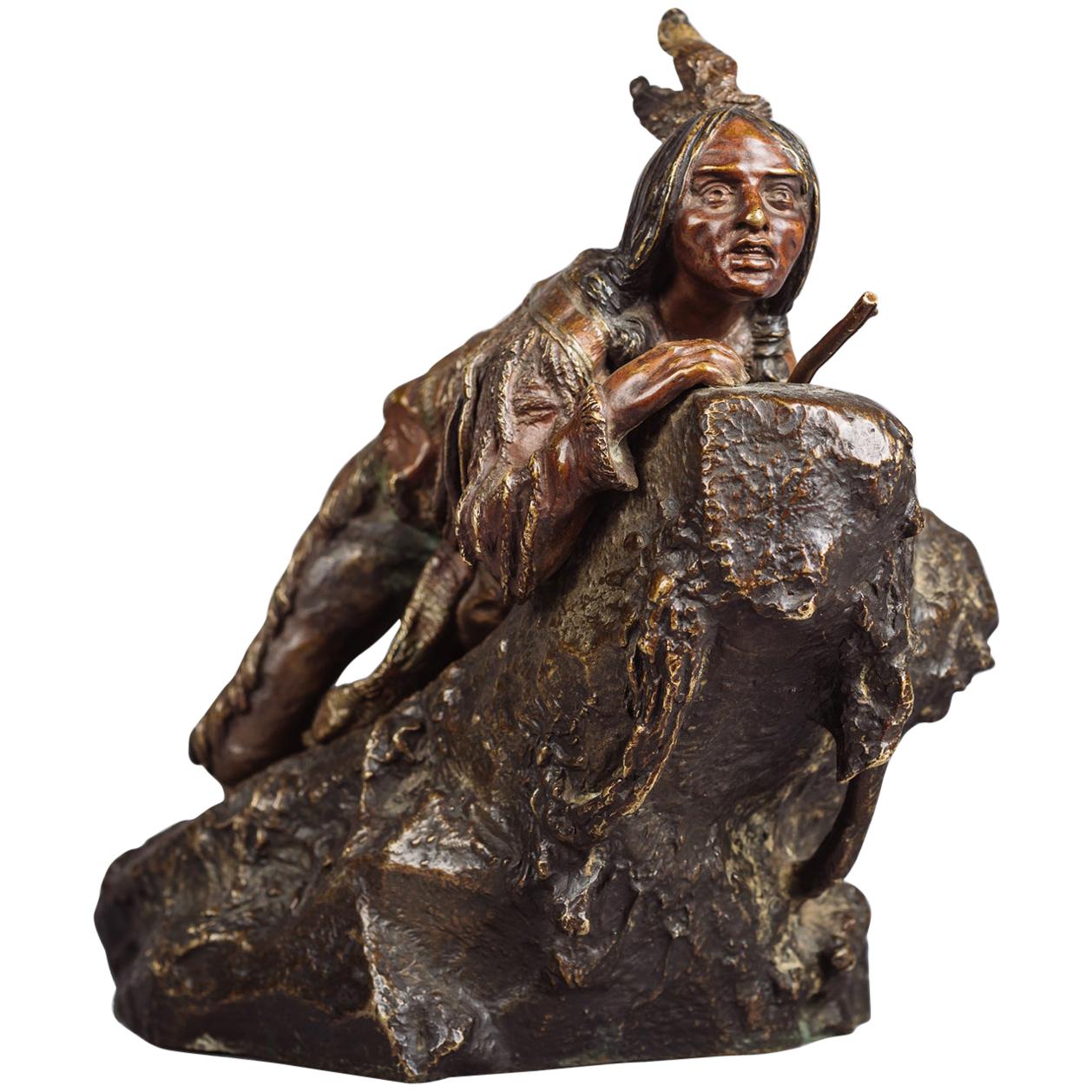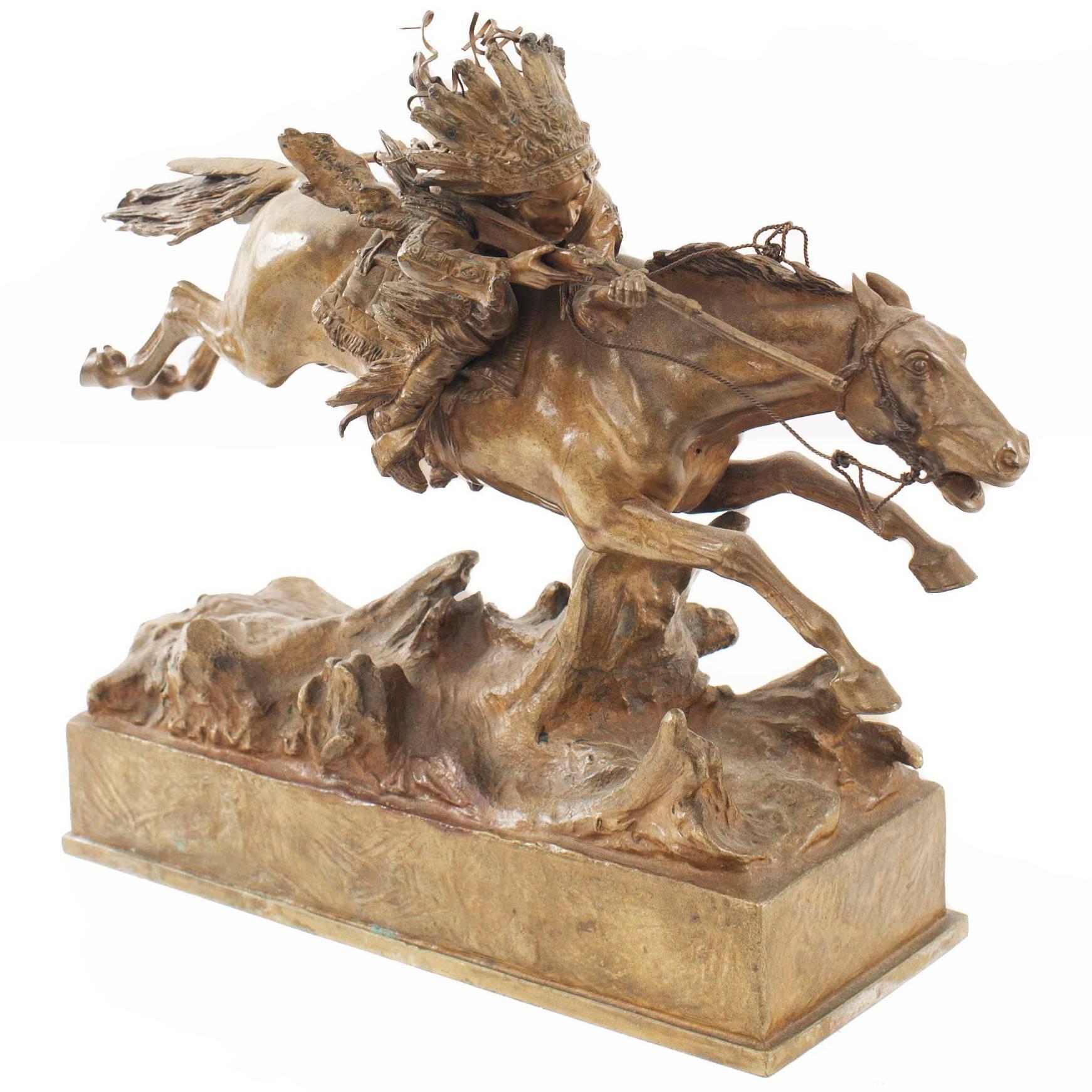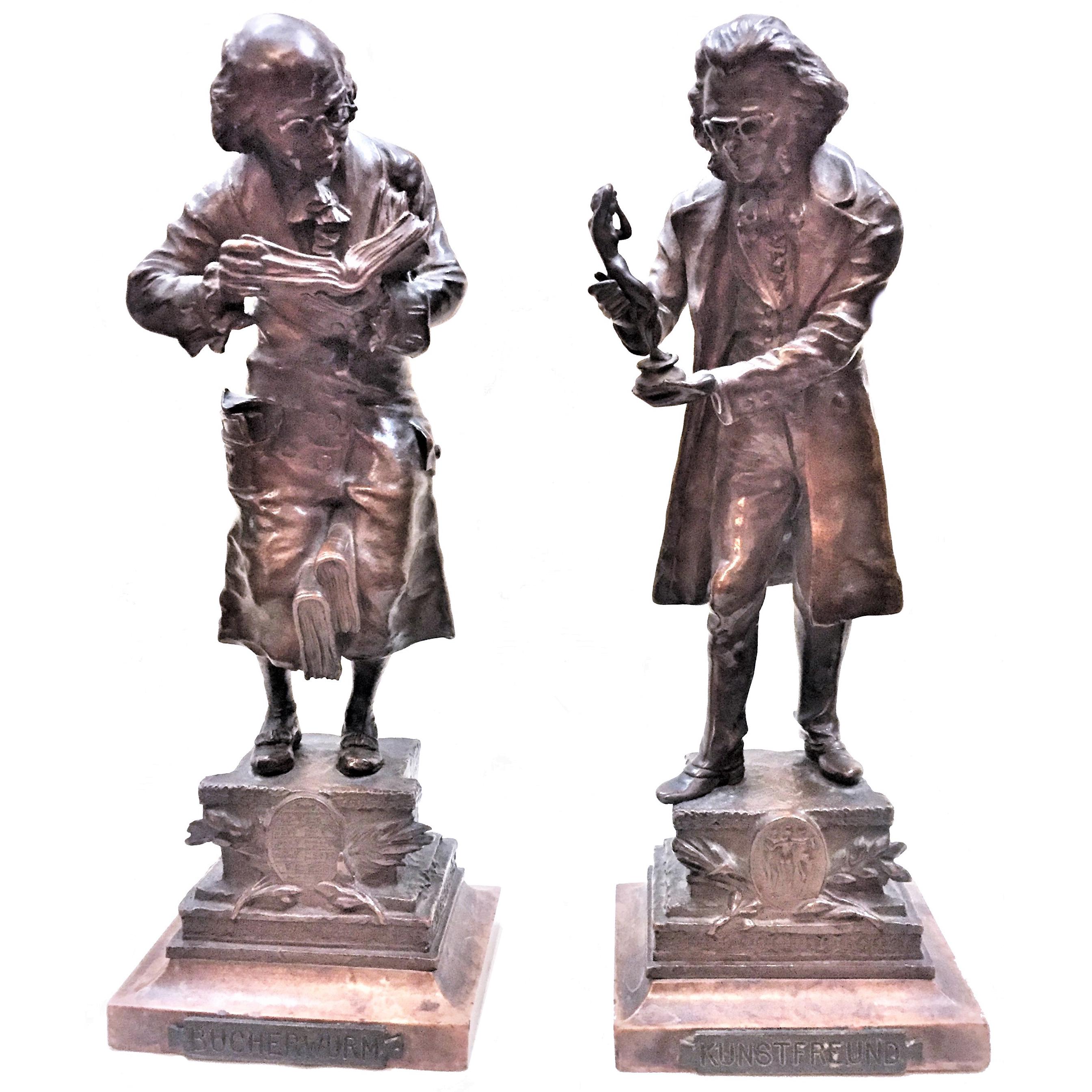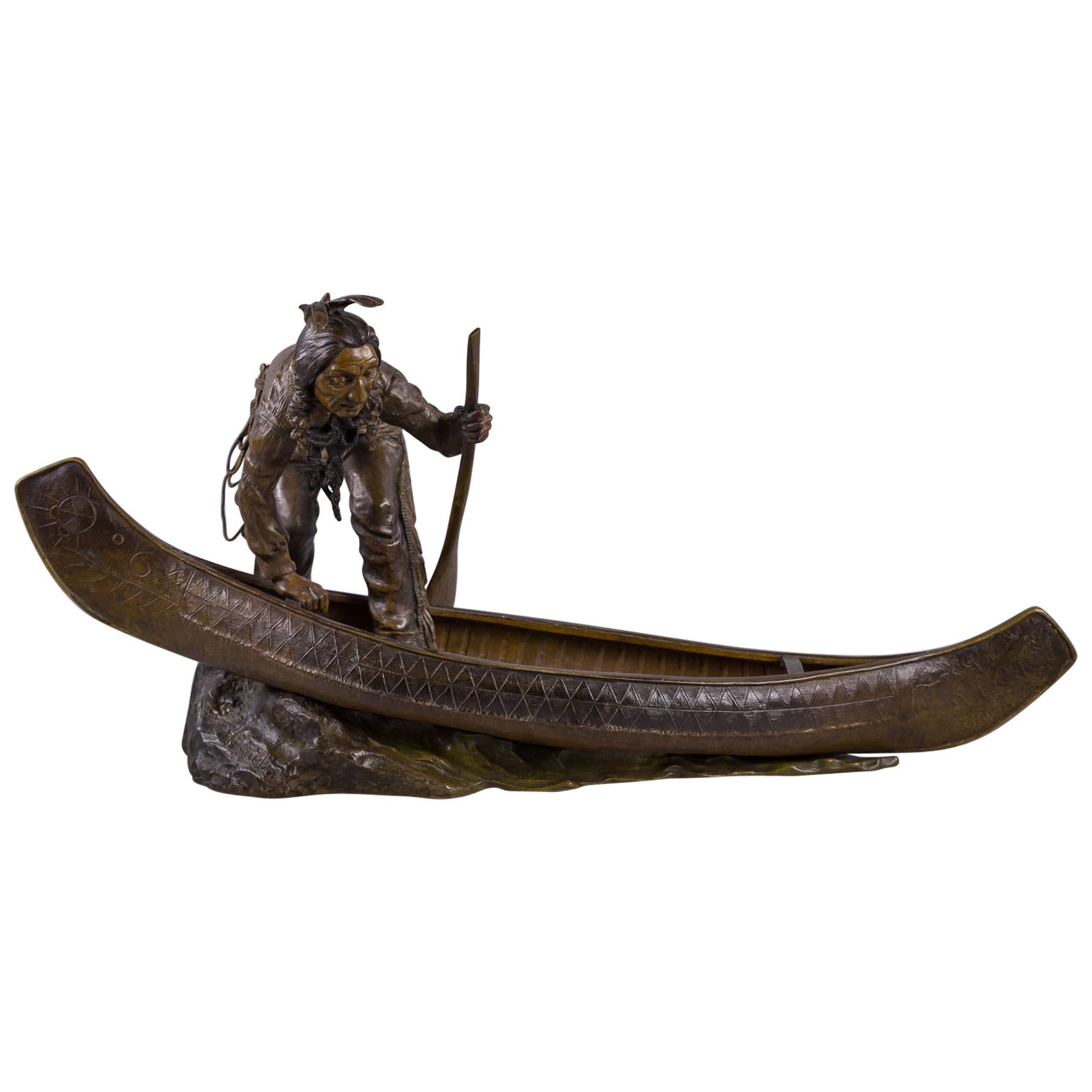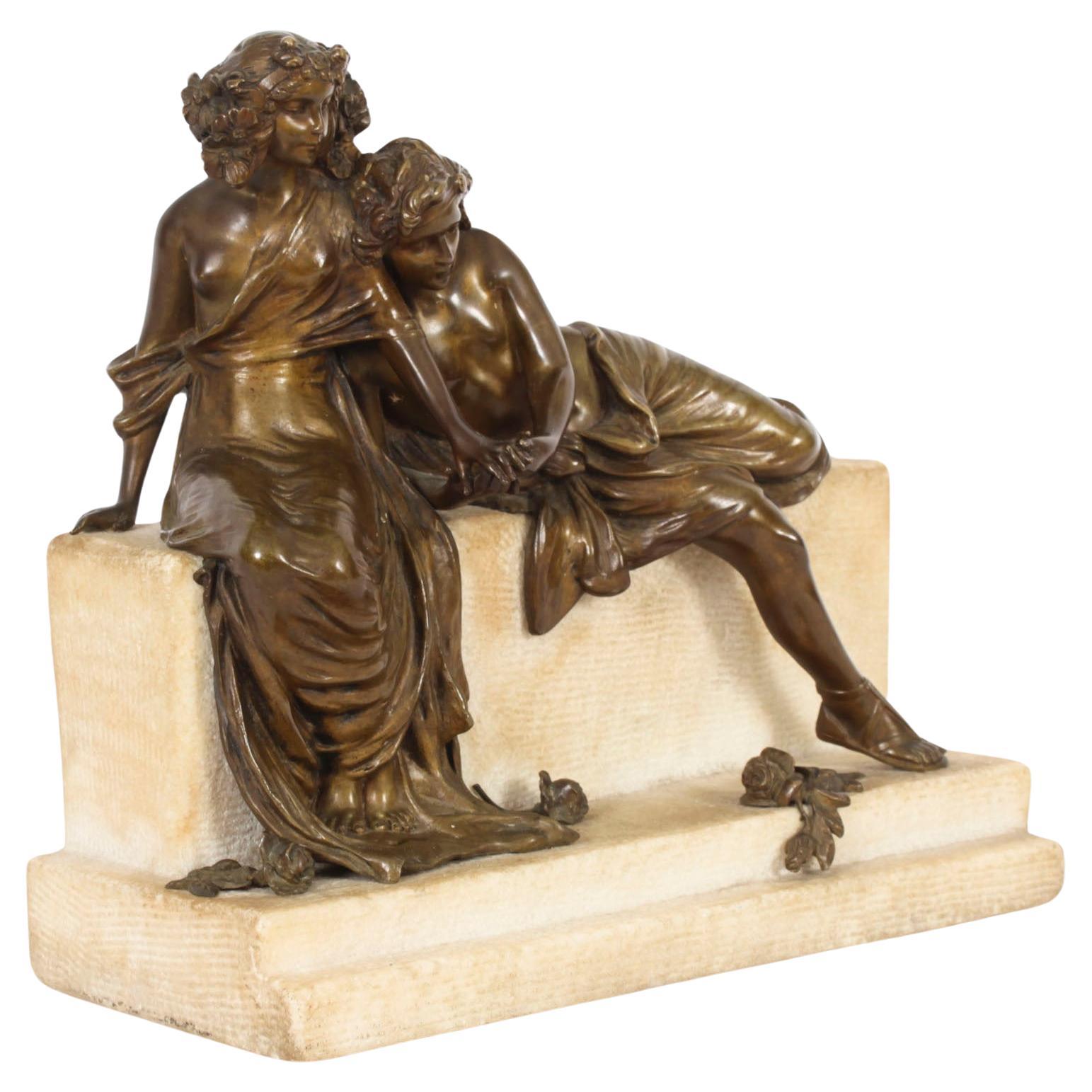Items Similar to Patinated Bronze Figure of a Native American Scout by Carl Kauba, circa 1910
Want more images or videos?
Request additional images or videos from the seller
1 of 7
Patinated Bronze Figure of a Native American Scout by Carl Kauba, circa 1910
About the Item
A fine patinated bronze figure of a Native American scout by Carl Kauba.
Austrian, circa 1910.
Signed in the cast 'Carl Kauba'.
The figure cast as an American Native scout peering over a rocky Austrian, circa 1910.
Carl Kauba (1865-1922) studied in Vienna under Carl Waschmann and Stefan Schwartz. Little is known about the life of this interesting sculptor who, in true Viennese style nearly always, but by no means exclusively, produced polychromatic bronzes, cold painted after casting and finishing.
Initially inspired by the romantic stories of the American West written by the German Carl May, his work is normally restricted to scenes from the Wild West rather than specific animals. His period casts are often by the Bergman Foundry.
- Creator:Carl Kauba (Sculptor)
- Dimensions:Height: 8.27 in (21 cm)Width: 4.73 in (12 cm)Depth: 9.06 in (23 cm)
- Materials and Techniques:Bronze,Patinated
- Place of Origin:
- Period:
- Date of Manufacture:circa 1910
- Condition:
- Seller Location:Brighton, GB
- Reference Number:
About the Seller
5.0
Recognized Seller
These prestigious sellers are industry leaders and represent the highest echelon for item quality and design.
Established in 1964
1stDibs seller since 2014
48 sales on 1stDibs
Typical response time: 1 hour
Associations
The British Antique Dealers' AssociationLAPADA - The Association of Arts & Antiques Dealers
- ShippingRetrieving quote...Ships From: Brighton, United Kingdom
- Return PolicyA return for this item may be initiated within 7 days of delivery.
More From This SellerView All
- Bronze Figure of a Native American Scout with Rifle by Carl Kauba, circa 1910By Carl KaubaLocated in Brighton, West SussexA fine patinated bronze figure of a Native American scout with rifle, by Carl Kauba. Austrian, circa 1910. Signed in the cast 'Carl Kauba'. The figure cast as an American...Category
Early 20th Century Austrian Figurative Sculptures
MaterialsBronze
- 'Bacchantes', a Fine Patinated Bronze Figural Group After Clodion, circa 1870By Claude Michel ClodionLocated in Brighton, West Sussex'Bacchantes', a fine patinated bronze figural group after Claude Michael Clodion, French (1738-1814). French, circa 1870. Signed 'Clodion' to the base and inscribed 'BACCHANTE...Category
Antique Late 19th Century French Figurative Sculptures
MaterialsBronze
- 'Grand Nu Aux Feuillages', a Fine Patinated Bronzed Figural Group, circa 1900By Alois MayerLocated in Brighton, West Sussex'Grand Nu Aux Feuillages', a fine patinated bronzed figural group by Alois Mayer. German, circa 1900. Signed 'A. Mayer'. Alois Mayer (1855-1936) Was a German Sculptor who...Category
Antique Late 19th Century German Figurative Sculptures
MaterialsBronze, Iron
- Pair of Patinated Bronze Figures by Émile Louis Picault, circa 1890By Émile Louis PicaultLocated in Brighton, West SussexA fine pair of patinated bronze figures of an archer and a scholar by Émile Louis Picault. French, circa 1890. Cast signature to each ba...Category
Antique Late 19th Century French Figurative Sculptures
MaterialsBronze
- ‘Gloria Victis’, A Patinated Bronze Figural Group by Mercié, Cast by BarbedienneBy Ferdinand BarbedienneLocated in Brighton, West SussexA Patinated Bronze Figural Group of ‘Gloria Victis’ (‘Glory to the Vanquished’), Cast by Ferdinand Barbedienne from the Model by Marius-Jean-Antonin Mercié (French, 1845-1916). ‘Gloria Victis’ (‘Glory to the Vanquished’). Bronze, gilt and dark brown patina. Signed 'A. Mercié', with foundry inscription 'F. BARBEDIENNE, Fondeur. Paris.' and A. Collas reduction cachet. The integral base titled 'GLORIA VICTIS'. This cast is part of a limited edition by the Barbedienne Foundry. France. Circa 1880. ‘Gloria Victis’ is one of the most recognisable and important works of sculpture of the nineteenth century and a definitive image of France’s historic national identity. The figure of glory, winged and wearing armour, carries a dying young warrior heavenwards towards fame and immortality. The compositional daring of the group must be admired for balancing two figures on the minimal support of one foot, wings spread in the moment before taking flight. Mercié was a student at the French Academy of Rome when the Prussians invaded France in 1870. Shortly after the war had begun, he executed a group depicting the figure of Fame supporting a victorious soldier. When news reached Mercié in Rome that the French had surrendered, he decided to alter his group, replacing the victorious soldier with a defeated casualty, thus transforming an allegory of ‘Glory to the Victors’ into one of ‘Glory to the Vanquished’. Completed in 1872, a year after the defeat of French soldiers against the Prussian army, the statue personifies a defeated but heroic France. The title is also a reversal of the famous formula, ‘Vae Victis’ (Death to the Vanquished), which the Gallic general Brennus exclaimed upon defeating the Romans in 390 BC. The figure of the fallen soldier was thought to represent Henri Regnault, a fellow sculptor of Mercié who was killed on the last day of fighting. Measuring 317 cm. high the original group of ‘Gloria Victis’ was unveiled in plaster at the Salon of 1872. It was bought by the City of Paris for the sum of twelve thousand francs and then cast in bronze by Victor Thiébaut for eight thousand five hundred francs. The bronze was exhibited at the Salon in 1875 and first placed in Montholon Square in the 8th arrondissement. In 1884 it was transferred to the courtyard of the Hôtel de Ville and in 1930, it entered the collection of the Musée du Petit Palais, where it can be seen to this day. The Thiébaut Frères foundry also cast Gloria Victis bronzes for the cities of Niort (requested 1881) Bordeaux (requested 1883), Châlons-sur-Marne (today, Châlons-en-Champagne; requested 1890), and Cholet (requested 1901). In 1905, the Danish brewer and art collector Carl Jacobsen was permitted to have an exact cast made of the original sculpture in Paris, on condition that the base was made 2 cm lower and bore the inscription “Original tilhører Paris By” (The original belongs to the City of Paris). It too was cast by the Thiébaut Frères foundry. Gloria Victis was one of Jacobsen’s most important and his last acquisition. Today it has been returned to its original position in the Winter Garden at Glyptoteket, Copenhagen, Denmark. The full-size plaster was shown again at the Paris Expositon universelle of 1878 alongside a bronze reduction by Barbedienne. By this time Antonin Mercié had entered into a commercial edition contract with the Ferdinand Babedienne foundry to produce bronze reductions of Gloria Victis, his most famous work. Gloria Victis is first recorded to have been produced in three sizes and by 1886 Barbedienne’s ‘Catalogue des Bronzes D’Art’ lists six sizes measuring 3/5, 9/20, 7/20, 3/10, 6/25 and 2/10, of the original. These reductions were produced by an invention of Barbedienne’s business partner Achille Collas. The Collas reducing machine was a type of complex mechanical pantograph lathe that enabled sculpture to be mathematically measured and transcribed to scale, in the round, thus making a reduced size plaster from which a bronze could be cast. Mercié's modern sculpture had become an instant classic, even receiving an entry in the Nouveau Larousse Illustré. The success of the group undoubtedly lay in the fact that it was admired not just on an aesthetic level, but also on a patriotic level, particularly in its commemoration of heroism in defeat. Immediately ‘Gloria Victis’ was recognised as a national artwork, capable of arousing patriotism and casts were ordered from Barbedienne as local memorials commemorating the war’s dead for cities across France. ‘Gloria Victis’ was considered so much a part of France’s national identity that for the 1900 Paris Exhibition, Ferdinand Barbedienne’s nephew Gustave Leblanc, loaned a bronze example to feature as part of l’Exposition centennale de l’art français. Literature: For an interesting account of the process of creating a reduction in bronze of the Gloria Victis by Barbedienne and illustrations of the casting and finishing of the bronze see: 'Ferdinand Barbedienne': Theodore Child; Harper's new monthly magazine, Volume 73, Issue 436, September 1886. ‘Contemporary French Sculptors’: The Century, Volume 33, Issue 3, Jan 1887. ‘Modern French Sculpture’: Harper's new monthly magazine, Volume 76, Issue 452, January 1888. S, Lami, ‘Dictionnaire des sculpteurs de l'Ecole française au dix-neuvième siècle’, Tome III. G.-M., Paris, 1914, p. 432. Peter Fusco and H.W. Janson, The Romantics to Rodin: French Nineteenth Century Sculpture from North...Category
Antique 19th Century French Figurative Sculptures
MaterialsBronze
- Large Multi-Patinated Bronze Figure of an Arab Warrior by Henri-Honoré PléBy Henri Honoré PléLocated in Brighton, West SussexA Large and Important Multi-Patinated Bronze Figure of an Arab Warrior by Henri Honoré Plé. Signed Henri Plé to the base. The figure is finely modelled as an Arab warrior, with sw...Category
Antique 19th Century French Figurative Sculptures
MaterialsBronze
You May Also Like
- Carl Kauba Bronze Native AmericanBy Carl KaubaLocated in New York, NYAustrian (19/20th Cent) bronze figure of a Native American with rifle riding on horse (signed C. KAUBA)Category
Antique 19th Century Austrian Figurative Sculptures
MaterialsBronze
- Pair of Patinated Bronze Native American Figures after KaubaBy Carl KaubaLocated in London, GBPair of patinated bronze Native American figures after Kauba Austrian, Early 20th Century Brave figure: Height 31cm, width 16cm, depth 19cm Chieftain figure: Height 28cm, width 16cm, depth 14cm This pair of cold-painted and patinated bronze figures were made by Alfonzo Titze, cast from models by Carl Kauba (1865-1922), who was a removed Austrian artist particularly known for his patinated bronze depictions of the Wild West. The bronzes portray a pair of Native Americans, each one standing on a rough-hewn deep red marble base. The first figure portrays a Native American warrior, called a brave. Leaning forward his mouth is open as if he is shouting. A small feather headdress ornaments the figure's head. Vibrant red frills are decorating parts of the trousers and shirt, an animal fur boa, as well as a yellow, blue, and white scarf covering his body. The chieftain who is portrayed in the second figure is wearing traditional Native American clothing...Category
Early 20th Century Austrian Figurative Sculptures
MaterialsMarble, Bronze
- Carl Kauba, Bookworm & Art Connoisseur, a Pair of Bronze Sculptures, circa 1910By Carl KaubaLocated in New York, NYBoth sculptures are signed ‘C. Kauba’ on the plinth. Dimensions: 9.75” high x 3.75” deep x 3.5” wide Dark brown patina. Original marble pedestals. Carl Kauba (Austrian, 1886 – ...Category
Vintage 1910s Austrian Romantic Figurative Sculptures
MaterialsMarble, Bronze
- Bronze Figure of Native American Stepping into a Canoe by Carl Kauba '1865-1922'Located in New York, NYInscribed 'C. Kauba' and stamped 'Geshutz'.Category
Antique 1890s Figurative Sculptures
MaterialsBronze
- Antique Bronze Marble Sculpure by Carl Kauba Circa 1890By Carl KaubaLocated in London, GBA superb antique bronze and marble sculputure group titled "The Betrothal" by Carl Kauba (1865-1922), circa 1890 in date. The bronze features a classical youth placing a ring on the...Category
Antique 19th Century English Figurative Sculptures
MaterialsMarble, Bronze
- Austrian Cold Painted Figure of an American Indian, by Carl Kauba (1865-1922)By Carl KaubaLocated in Petaluma, CAThis highly detailed casting of an American Indian was done by one of the noted artists of the old American West, Carl Kauba. The figure also shows off Kauba's attention to detail ...Category
Early 20th Century American Other Figurative Sculptures
MaterialsBronze
Recently Viewed
View AllMore Ways To Browse
Native American Gold
Bronze Sculpture 1910
Carl Bronze
Viennese 1910
Cold Painted Bronze Figure
American Figurative Sculptors
Viennese Bronze Sculptures
Vienna Bronze Figure
Bronze By Bergman
Austrian Cold Figure
Viennese Cold Painted Bronze
Wild West Sculptures
Wild West Furniture
Antique Wild West
Kauba Bronze
Kauba Carl
Carl Kauba Bronze
Bronze Figure Native American
